During December of 1833, Zerah Pulsipher was at work, threshing grain in his barn when he felt a strong prompting that he needed to travel north because the Lord had something for him to do there.[1] One account from Zerah’s son Charles Pulsipher outlines the events that occurred in his home in relation to this prompting:
Father was ordained an Elder & set apart to… travel & preach as the spirit might direct & while working in the field the spirit moved upon him to start out & go North & preach the gospel, he stoped & thought on it & finely conclouded to work on untill night & then he would more think more about it but the spirit soon told him to go north on a mission so he quit work & went home & told Mother to get his clothes ready for he was going on a mission in the morning. where are you going. I don’t know, only I am to go north. How long will you be gone? I don’t know that.
He got Bro. Cheney who had been ordained a decon to go with him. They travled two days, about 80 miles from home & just before sundown father looks ahead of them & said, do you see that little house in the clearing? Yes, well, that is where we are to stop.[2]
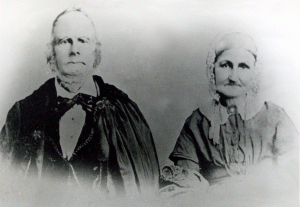
Image courtesy of the Daughters of the Utah Pioneers museum, Salt Lake City, Utah.
Two brothers lived at this house in Richland, but they weren’t home at the time. The wife of one of the brother was, however, and she let the elders in. They informed her that they were Mormon elders who felt they had been called of God to go north and preach about the restored gospel of Christ and that they had “traveled sixty miles on foot… in deep snow, and the first place they felt impressed to call upon was the house.”[3] They then asked “can you keep t[w]o travleing preachers of the great Later Day Gospel? Well yes she said, I guess so. We never turn away preachers. So they went in & she prepared supper for them.”[4] When they explained what they were preaching, she told them that her husband and brother-in-law would be interested in hearing what they had to say. When her husband came home, Zerah asked him, “Do you think we cant get a meeting tonight?” The husband’s response was, “I guess so. I will go out & see about it.” Accordingly, “He gave out the word & lit up the school house.”[5] The elders set up a meeting in the schoolhouse on the farm, and circulated notices throughout the village that they were to preach that evening.[6]
Little did the missionaries know then that one of those brothers would become, in the words of historian Thomas G. Alexander, “arguably the third most important figure in all of LDS church history after Joseph Smith, who began Mormonism, and Brigham Young, who led the Saints to Utah and supervised the early colonization of the intermountain west.”[7] For the time being, however, the two brothers—Wilford and Azmon Woodruff—were young seekers living in rural New York State.
The reason Azmon’s wife knew that the two men would be interested in what Zerah and Elijah had to say was that it was a lifelong quest of theirs to find the restored primitive church with apostles and prophets and had often discussed it at their home.
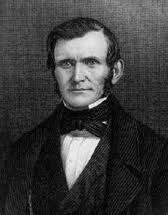
Wilford had grown up in Connecticut under a strict Presbyterian upbringing. Through studying the New Testament and the tutelage of a visionary man named Robert Mason, Wilford came to believe that “it was necessary to have prophets, apostles, dreams, visions and revelations in the church of Christ, the same as they had who lived in ancient days” and that “the Lord would raise up a people and a church, in the last days, with prophets, apostles and all the gifts, powers and blessings, which it ever contained in any age of the world.”[8]
Wilford thought much upon this subject, especially while he was a teenager and in his early twenties. When he was 23, he resolved to seek out the truth. He “attended the meetings of almost every demonization there was,” but had no desire to join any existing church, feeling that they were incomplete and that the Lord would one day bring His church back upon the earth. Yet, he wasn’t afraid to express his views to other religious people when given the opportunity. On one occasion he attended great meeting with ministers from all sorts of denominations present. He arose and stepped into the aisle and asked, “My friends, will you tell me why you don’t contend for the faith once delivered to the Saints? Will you tell me why you don’t contend for that Gospel that Jesus Christ taught, and that His Apostles taught?” Then he proceeded to name off the gifts he felt were necessary to the Church of Christ.
In response, the leader of the convention responded that,
My dear young man, you would be a very smart man, and a very useful man in the earth, if you did not believe all those foolish things. These things were given to the children of men in the dark ages of the world, and they were given for the very purpose of enlightening the children of men in that age, that they might believe in Jesus Christ. Today we live in the blaze of the glorious gospel light, and we do not need those things.
To this, the young Wilford simply stated, “Then give me the dark ages of the world; give me those ages when men received these principles.”[9]
Wilford still felt this way when he came home from drawing logs from the shores of Lake Ontario on the 29th of December 1833. He recorded that,
Upon my arrival home my sister-in-law informed me of the meeting. I immediately turned out my horses and started for the schoolhouse without waiting for supper. On my way I prayed most sincerely that the Lord would give me His spirit, and that if these men were the servants of God I might know it, and that my heart might be prepared to receive the divine message they had to deliver.
When I reached the place of meeting, I found the house already packed. My brother Azmon was there before I arrived. He was equally eager to hear what these men had to say. I crowded my way through the assembly and seated myself upon one of the writing desks where I could see and hear everything that took place.
Elder Pulsipher opened with prayer. He knelt down and asked the Lord in the name of Jesus Christ for what he wanted. His manner of prayer and the influence which went with it impressed me greatly. The spirit of the Lord rested upon me and bore witness that he was a servant of God. After singing, he preached to the people for an hour and a half. The spirit of God rested mightily upon him and he bore a strong testimony of the divine authenticity of the Book of Mormon and of the mission of the Prophet Joseph Smith. I believed all that he said. The spirit bore witness of its truth. Elder Cheney then arose and added his testimony to the truth of the words of Elder Pulsipher.[10]
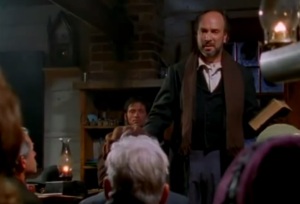
Wilford later stated that he “truly felt that it was the first gospel sermon that I had ever herd . I thought it was what I had long been looking for. I could not feel it my duty to leeve the house without bearing witness to the truth before the people.”[11] He got his chance to do so very quickly:
Liberty was then given by the elders to any one in the congregation to arise and speak for or against what they had heard as they might choose. Almost instantly I found myself upon my feet. The spirit of the Lord urged me to bear testimony to the truth of the message delivered by these elders. I exhorted my neighbors and friends not to oppose these men; for they were the true servants of God. They had preached to us that night the pure gospel of Jesus Christ. When I sat down, my brother Azmon arose and bore a similar testimony. He was followed by several others.[12]
The Woodruff brothers invited Zerah and Elijah to come to their home that evening and visited with them. Wilford borrowed the Book of Mormon and read it all that night. While reading, the Spirit bore witness to him that this volume was a true record.[13] Wilford later wrote, “Brother Pulsipher Continued labouring with us for several days and on the 31th of Dec I with my Brother Azmon Woodruff with two young females… went forward in baptism.”[14] Zerah performed the ordinance, even though conditions were not ideal for a baptism at the time—there was about three feet of snow on the ground, the day was very cold, and the water was mixed with ice and snow. Despite all this, Wilford later recalled that he did not feel the cold.[15]
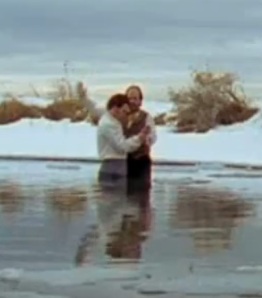
The Mormon missionaries continued to labor in the area and baptized several other people in the following days and weeks. On January 2, Zerah established a branch of the Church of Christ in Richland that contained twelve members. Wilford was ordained a teacher while Azmon and Noah Hatton were ordained elders in this branch.[16] After this, Charles recalled, that, “Then they felt their mission was filled & they returned home.”[17]
Wilford Woodruff would later serve as a member of the second quorum of the seventies and as an apostle, serve several successful missions bringing hundreds of people into the Church of Jesus Christ of Latter-day Saints, and later served as president of the Church. While serving in this last position, Wilford Woodruff issued the Manifesto (published in the Doctrine and Covenants as Official Declaration 1), which declared that the Church was “not teaching polygamy or plural marriage, nor permitting any person to enter into its practice.” While this statement would not be completely true until a few years later, this statement marked the beginnings of an era of transition that would reshape Mormonism. As Thomas G. Alexander stated while arguing that Woodruff was, perhaps, the third most important figure in Mormon history,
A man for his season, Woodruff shepherded Mormonism out of a morass of persecution and isolation. He marked the path which led the Latter-day Saints to come to terms with the separation of the temporal and spiritual and to acceptance and respectability; and he reclaimed and deepend the reservoir of spiritual water that nourished the Saints through trying times.[18]
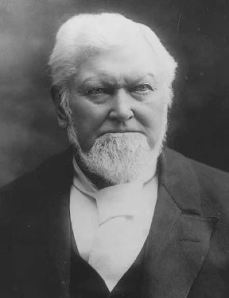
[1] Wilford Woodruff, “The Birthday Reception,” Deseret Evening News, 1897, March 1, p. 1.
[2] Charles Pulsipher Autobiography and Journal. Copy in possession of author.
[3] Woodruff. “Birthday Reception,” 1.
[4] Charles Pulsipher, Autobiography and Journal.
[5] Charles Pulsipher, Autobiography and Journal.
[6] Woodruff. “Birthday Reception,” 1.
[7] Thomas G. Alexander, Things in Heaven and Earth, the Life and Times of Wilford Woodruff, a Mormon Prophet, [Salt Lake City: Signature Books, 1991], 331.
[8] Wilford Woodruff, Leaves From My Journal, 2nd ed. (Salt Lake City, UT: Juvenile Instructor Office, 1882), 1-2.
[9] Wilford Woodruff, and A. Winter (ed.), “Discourse,” Deseret Weekly, 1889, April 6, pp. 449-450.
[10] In Matthias F. Cowley, Wilford Woodruff, Fourth President of the Church of Jesus Christ of Latter-day Saints: History of His Life and Labors as Recorded in His Daily Journal (Salt Lake City, UT: Deseret News, 1909), 33
[11] Wilford Woodruff Journal introduction. Quoted in Wilford Woodruff, Waiting for the World’s End, ed. by Susan Staker. (Salt Lake City, UT: Signature Books, 1993), 2
[12] Cowley, p. 33.
[13] Cowley, p. 34.
[14] Woodruff, Journal Intro in 1993, 1-2.
[15] Cowley, p. 35.
[16] Wilford Woodruff journal intro. For other accounts of Wilford’s conversion, see Woodruff, W. (1897, March 1). The Birthday Reception. Deseret Evening News, p. 1; Jensen, A. (1886). Wilford Woodruff. The Historic Record vol. 5. Salt Lake City: Andrew Jensen, p. 93
[17] Charles Pulsipher.
[18] Alexander, Things, 331.


One thought on “Wilford Woodruff Conversion”